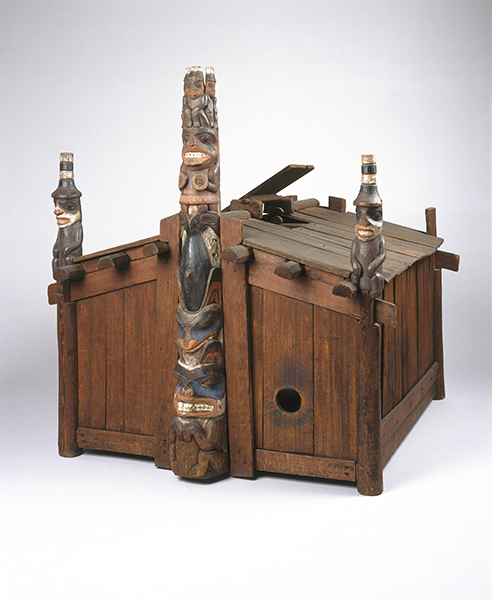Haida Artist George Dickson
Haida artists were traditionally renowned for the beauty of their carvings, particularly in wood. Because of the abundance of timber in their lands, Haida artists were able to create monumental works such as totems, clan crests, bentwood boxes, coffin boards, canoes, and ritual objects with beautiful painted decoration. Following the tragic depopulation of the late 1860s due to epidemics and deculturation in the 1870s and 1880s, the monumental sculptural tradition was largely abandoned by Haida artists. Sculptors miniaturized their production into models of houses and poles, tailoring their art to the tourist market.
 |
| George Dickson (active late 1800s-early 1900s, Haida, British Columbia, Canada), Model of House of Contentment, 1890s. Cedar and pigment, 36 ⅝" x 34 ⅝" x 35 ⅞" (93 x 88 x 91 cm). © 2021 Brooklyn Museum. (BMA-5190) |
House models were a favorite souvenir of early tourists, and Haida artists embellished them with every conceivable traditional motif. Works such as this are a valuable historical record of an all-but-vanished way of life.
Haida artist George Dickson made this house model for the Chicago 1893 World’s Columbian Exposition. It replicated the family compound—House of Contentment—built in Skidegate (HIGaagilda) by his great grandfather. Native artists that year reproduced an entire copy of Skidegate village for the Exposition. House of Contentment was part of an amazing reconstruction of twenty-seven model houses (most with frontal poles), two model mortuary houses, and seventeen free standing model poles, commissioned from Haida artists who had gone through the traditional artistic apprenticeship.
This model depicts a typical Haida clan house, one in which potlatch celebrations were held in winter. The house features a welcome totem next to the front door. The totem pole’s figures represent a wasgo (sea wolf), a whale, a female shaman, and three watchmen at the top. The corner posts also contain watchmen carvings, thought to protect the village from evil spirits.
There is archeological evidence that the Haida people had a sizeable population as early as 5000 years ago. Additionally, they are believed to have migrated more than 14,000 years ago over the land bridge between Asia and Alaska. By 800 CE, they reached British Columbia and populated Queen Charlotte Islands a few centuries later. They formed their own language, which imitates sounds in nature.
Traditional Haida society was organized around two major clans, the Raven and the Eagle. Each of these two subdivisions consisted of many extended lineages, occupied separate lands, and had different chiefs. The extended lineages function independently.
Haida's traditional territory encompasses the archipelago of Queen Charlotte's Islands, parts of southern Alaska, and their surrounding waters. While they live throughout these lands, the two main centers are Old Masset (Gaw) at the north of Graham Island and Skidegate on the southern end. Vancouver and Prince Rupert also have large populations of Haida.
Dickson was one of the first Haida artists who lived from his artwork. He began making model-sized replicas of Haida art for tourist interest in the 1880s. At the same time, he was able to supply Haida customers the necessary ritual and cultural art works for which he is so renowned.
More First Nations art in Davis Programs: Explorations in Art 2E Grade 2: 5.7; Explorations in Art 2E Grade 3: 6.7; Explorations in Art 2E Grade 4: Unit 5 intro; Explorations in Art 2E Grade 5: 2.5; Explorations in Art 2E Grade 6: 2.8, 3.8, 4.4, Unit 5 p. 151; A Community Connection 2E: 1.4; A Global Experience 2E: 2.5; Beautiful Stuff from Nature: Section 3 p. 48; Experience Clay 2E: Chapter 2 p. 32, Chapter 5 pp. 147 and 180; Exploring Visual Design 4E: Chapter 11 p. 211


Comments